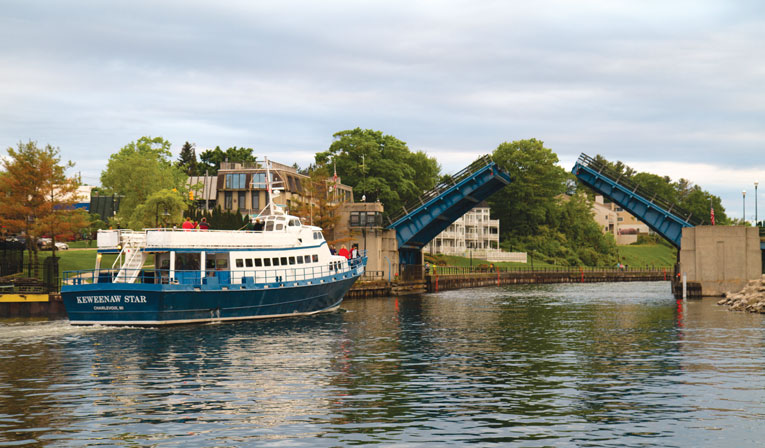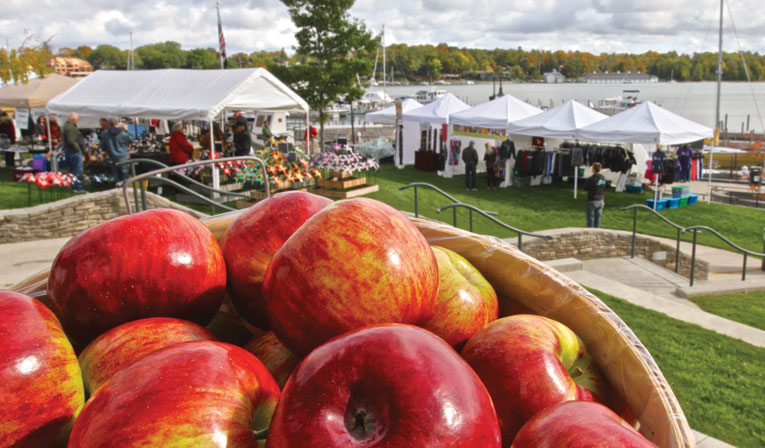Photo by Always Photographic
Nicknamed the “Queen of Northern Resort Country,” this charming Michigan town lives up to its moniker, offering visiting boaters an abundance of delightful views, culinary treats and good, old-fashioned history.
As the drawbridge lifts and we motor between Lake Michigan and Charlevoix’s Round Lake, the only thing missing is the blare of a trumpet or two. Like visiting royalty is the best way we can describe how we’re feeling, as spectators smile or shout “Hello!” from nearby benches and balconies lining the Pine River channel. We respond from the deck with our best renditions of a float-queen wave.
It’s probably just the unseasonable sunshine and the crowd appeal of our vessel — the 114-foot Traverse City-based tall ship Manitou — that lends the sense of being honored guests to this vacation kingdom as we pass through the grand opening. The entry itself isn’t all that exclusive, nor are we the first to discover this one-time vacation playground in the early 1900s dubbed “Queen of the Northern Resort Country.”
Since 1859, this and the five bridges that came before have been raised more than 550,000 times, according to Dave Miles of the Charlevoix Historical Society, as vessels from around the world came calling. Many more have glided through, from simple early canoes to some of the biggest passenger boats to ply the inland lakes.
There actually was a self-proclaimed king in Charlevoix’s history, though with no relation to the drawbridge. His legacy was focused mostly on nearby Beaver Island, on “King” James Jesse Strang’s Mormon “kingdom,” but there was a gun battle between Strang’s followers and Charlevoix fisherman on the town’s Lake Michigan Beach. There were pirates in the day, too, which newspaper articles linked to the said “king,” and there also was a still-remaining castle — this one related to a king of American industry, a former vice president for the Sears Roebuck Co., who built the French Normandy-style complex of boulders as a way to showcase Sears farm implements. (Castle Farms is now available for weddings, teas and tours.) There also were tourists who came by the droves to enjoy pretty much the same exact scene greeting us in the idyllic harbor.
FUN FACT:
The Ironton Ferry, a steel vessel built in 1927, takes four cars on the short, 650-foot crossing of Charlevoix’s south arm and is modern by Ironton standards. A scow, pulled by hand and later by horses, once hauled sheep, horses, buggies and more across. Former Captain Sam Alexander is listed in Ripley’s Believe it or Not for traveling 15,000 miles while never being more than a quarter-mile from home!
Scenic, culinary and shopping delights
Tree-lined bluffs add to the secret discovery feel, and colorful spinnakers a touch of whimsy to elegant mansions dating to the turn of the last century. Here, we also note the Christmas morning sense that we haven’t felt at other harbor stops on our trip, a palpable excitement to open the travel gifts that await. Resort amenities that have continually evolved since the town’s earliest tourist Mecca days and now include weekly outdoor concerts, movies, lively art and food fests.
Charlevoix City Marina is located in the heart of downtown Charlevoix, just steps from all the town has to offer. There are 60 transient slips, which fill up quickly, so be sure to make a reservation.
On lively Bridge Street, the main thoroughfare conveniently bordering the marina, we sample the prized culinary treats of Michigan’s north in shops dedicated to fudge (Celeste Murdick’s Fudge and Candy Kitchen), cherries (Cherry Republic, with its 175 different products all made from cherries), and farm-grown and foraged fruits made into upscale canned goods (American Spoon Foods). There are high-end delis and fine dining, too, at spots like elegant new Quay, with views hard to beat from the third floor, open-air bar and the Bridge Street Bistro, where you want to grab a window seat overlooking the channel and order the decadent lobster butter burger.
Visit North Seas Gallery and Antiques for unexpected-on-this-continent paintings by Dutch masters and a collection of bronze statues that pay homage to laborers, or venture a few miles south of town to Beir Art Gallery and Pottery Studio to see the combined works of some 100 areas artists and the pottery of the Bier family, often found working in their open studio on pieces inspired by local woods and lakes.
An avid boater — who doubles as a local attorney — launched visit-worthy Round Lake Books; check out the staff recommendation shelf and store dogs like Cody, a Newfoundland and longtime boat dog often sprawled in the middle of the aisle.
Whether your Northern Michigan vacation plans are for a night, a week or the entire summer, Charlevoix Rental Company offers waterfront and in-town homes, cottages and condos in Charlevoix for your next vacation rental. Pointes North Inn offers one- and two-bedroom suites within walking distance to downtown.
Nestled on the north shore of Round Lake harbor and the Pine River channel near the bridge you will find the Edgewater Inn. This waterfront condominium hotel offers stunning views of the harbor in the heart of downtown Charlevoix.
On the southwest corner of Round Lake, you’ll find Ward Brothers Boats, founded by Bernie Ward Sr. and Archie Ward in 1934. They opened what was referred to as a “fishing shack.” This family-owned business has grown into a full-service marina with another generation of Ward brothers at the helm. In addition to all the regular amenities, they offer fuel, boat rentals, fishing charters and boat rides.
Two other established Charlevoix businesses, Bergmann Marine and Irish Boat Shop, offer boat sales, service and storage if needed while in town.
Only a short walk from downtown Charlevoix, Northwest Marine Yacht Club is perfect for a summer stay or a day or two stop to enjoy the area. Loaded with amenities and a terrific staff, this marina is a popular stop-over for those heading up or down the coast.

Photo by Tiffany Joyce
Explore the Emerald Isle
 At 13 miles long and 6 miles wide, Beaver Island is the largest inhabited island in Lake Michigan. But, as chamber director Steve West likes to point out, “You won’t find Beaver Island fudge, and we keep the horses in the fields where they belong.”
At 13 miles long and 6 miles wide, Beaver Island is the largest inhabited island in Lake Michigan. But, as chamber director Steve West likes to point out, “You won’t find Beaver Island fudge, and we keep the horses in the fields where they belong.”
Wildlife is one draw. There’s a whitetail deer or wild turkey sighting around most every corner; a new bird trail highlights hot spots for viewing the many shorebirds and colorful warblers that nest or migrate through, as well as inland lake loons and majestic raptors; and national fishing shows have showcased the hot new fishing phenomenon — fly fishing — for massive carp in the flats.
Not even the most imaginative HBO special could beat the storied history of James Jesse Strang, the island’s one-time, self-proclaimed king, a Mormon polygamist and former state legislator also purported to be one of the most treacherous pirates of the Great Lakes. That story is well interpreted in the island’s Mormon Print Shop Museum, built in 1850 by Strang’s followers.
Get there via the Beaver Island Boat Company (BIBCO) ferry, a vacation in itself; your own boat; or one of two flight companies that serve the island.
BIBCO has been providing ferry service from Charlevoix to Beaver Island for more than 30 years. Passengers get acquainted to island time as they cruise Lake Michigan. Their guided van tours are the best way to see all the highlights of America’s Emerald Isle.
West also recommends taking in a festival like the popular Baroque on Beaver music festival, now a week long; climb a lighthouse; paddle or peddle via a new outfitter that rents kayaks, paddleboards and bikes at a kiosk near the harbor; and dine, the easy way. The Beaver Island Lodge caters to boaters, picking them up prior to their dinner reservation and returning them to their boats after.
For more information, visit beaverisland.org. — K.S
Photo by ryangs
Photo by John Menard
Beautiful then and now
The town takes some good-natured ribbing for the way its signs read “Charlevoix the Beautiful,” evidenced by the way someone penned “the adorable” to the welcome sign of nearby village Atwood. But the descriptor was officially combined with the name back in 1882. The adjective was used far earlier, by namesake Father Pierre-Francois-Xavier de Charlevoix, a French Jesuit missionary and explorer who was passing by in search of a Northwest passage to the Pacific when he, in a journal entry, wrote of the town: “Were we to sail then as I did, with a serene sky, in a most charming climate, and in water as clear as that of the purest fountain… breathe at our ease the purest air… we might possibly be tempted to travel to the end of our days.”
Charlevoix didn’t know at the time how many people the pure air and North Woods serenity would later draw, or that industries like logging and fishing would put the town on the map. By 1908, Miles said, Charlevoix boasted the largest fish exporting port on the Great Lakes, and what was called “finny gold” seemed an inexhaustible resource.
Tourism was hot as early as 1881, though, when an editorial in the Charlevoix Sentinel proclaimed: “You lift your eye and the broad Lake Michigan stretches away beyond the islands and fro it comes a refreshing breeze, cooling your heated flesh and driving away your headache with a magic akin to that of mesmerism.”
The town thrived through Prohibition. The converted lumber barge Keuka was a popular speakeasy until a murder on board made it an investigation target and the owner sunk it to avoid prosecution, according to historian Chris Struble, who serves as president of the Michigan Hemingway Society. Hemingway noted Charlevoix in his writings and got his marriage certificate in town; the signed original copy is on display in the Harsha House Museum, though Struble claims that both Hemingway and bride Hadley Richardson lied about their ages on the form.
Tours From Fairy Land
They seem to have sprung, hobbit-style, from Middle Earth, so it’s no surprise that Charlevoix’s Earl Young houses attract the curious, sometimes by the one or two, sometimes by the busload. One of Charlevoix’s first architects, Young moved to town in 1900 when it was a rutted dirt road bordered by wood plank sidewalks and gas lanterns. A young boy then, he explored the lakeshores, fields and woods of the north and became inspired by both nature and the many boulders he found — and started collecting. He later enrolled at the University of Michigan’s School of Architecture, then dropped out to apprentice to a stone mason. And stone, particularly boulders of many shapes and colors, characterize the some 30 houses he built between 1918 and the early 1950s, as does his clear sense of whimsy.
Many of Young’s still-standing designs were part of an early luxury resort community overlooking Lake Michigan, the aptly named Boulder Park. Others are a short stroll from the marina, just past the Harsha House Museum. The museum also offers free maps to the self-guided tour of Young’s designs, easily identifiable by wavy roofs that seem to fly; the Cotswold-style designs like one that originally sported a thatched roof imported from England; and even his “Half House,” seemingly designed for hobbits or fairies.
FUN FACTS:
Charlevoix has been named one of “America’s Prettiest Towns” by Forbes magazine, the second “Best Yachting Town in the World” by Yachting magazine, and the “Best Area for a Vacation Home” by Detroit Home magazine.

Photo courtesy of the Charlevoix Convention & Visitors Bureau
Lake Charlevoix
Connected to Round Lake is Lake Charlevoix, the third largest lake in the state, with 56 miles of shoreline. Young State Park is located on the shore of the lake just northwest of Boyne City. The Ironton Ferry at Ironton, in operation since 1876 and a designated Michigan Historical Site, crosses the south arm.
It’s here that you’ll find The Landing Restaurant returning this summer after undergoing an extensive transformation. A favorite for generations, enjoy waterside dining, tasty food and live music.
Located at the south end of Lake Charlevoix is Sommerset Pointe Yacht Club, the perfect home base while you spend time exploring Lake Charleviox from Boyne City to East Jordan to Charlevoix and everywhere in between. Everyday is a perfect day on the water, even if you never leave the dock!
To experience a simple alternative to boat ownership without any of the hassle, check out the Freedom Boat Club of Lake Charlevoix at Sommerset Pointe. Enjoy the relaxation and exhiliration of the boating lifestyle with none of the headaches. You choose your time, your boat and they take care of the rest. Take out a pontoon for fishing in the morning, a speedboat for wakeboarding in the afternoon, and a pontoon again for an evening cruise. The possibilities are endless. [Note: Look for a feature story on Freedom Boat Club in our April 2015 issue.]
Fun for everyone
Modern-day tourism pursuits often come with a historic twist. Tee off at the Belvedere Club, and you’ll be playing one of Michigan’s oldest courses, dating back to 1925 when members of the Charlevoix Summer Resort Association decided their social club needed a golf course and called on a local Scotsman and course architect.
After you’ve worked up an appetite, walk through the well-weathered door at John Cross Fisheries and catch the multi-generational fishing rhythm as you order whitefish or walleye straight from the boat or the famed Three Fish Dip from a third generation owner like John Cross III.
History is framed on the walls of the Bridge Street Tap Room, in the form of photos of historic lighthouses and city drawbridges and story-worthy boats. Michigan is exclusively represented in the 32 taps of microbrews, cider, wine and root beer. Adam Engelman, a Tap Room partner and area boater, says the restaurant and pub’s focus is the region — and the stunning floor-to-ceiling views of the region’s biggest visitor draw: The water.
“Here you have big water and inland water, with different wind patterns on each of the lakes,” he says. “There are restaurants and beaches, and if you want to check out the sunset, you go under the drawbridge, out past the lighthouse into Lake Michigan, for a beautiful unobscured view. In Charlevoix, you have the best of a lot of worlds.”
Forage for Dinner
 The hardwood forests near Lake Charlevoix are among the Midwest’s best hunting grounds for the culinary treasure of the spring North Woods: The morel. The edible mushroom resembling a honeycombed umbrella is so rare and delicious that it sells for up to $50 a pound in local groceries — if you are lucky enough to even find them.
The hardwood forests near Lake Charlevoix are among the Midwest’s best hunting grounds for the culinary treasure of the spring North Woods: The morel. The edible mushroom resembling a honeycombed umbrella is so rare and delicious that it sells for up to $50 a pound in local groceries — if you are lucky enough to even find them.
Once secured, they’re best served grilled, sautéed in butter or fried, ideally paired with spring leeks (another woodsy prize), a thick steak, or as the star of a creamy risotto, says Scott MacKenzie, an avid amateur hunter, guide and host of the annual National Morel Mushroom Festival in nearby Boyne City, Michigan. The festival celebrates its 55th year this May 15-18 and is worth a visit to see how local chefs will seek to outdo one another with their gourmet spins on the morel in the annual Taste of Boyne event. There’s also a guided hunt with tips for beginners and a more animated competition of the experts who, on a good year, in which there’s been plenty of rain, cool nights and warm days, find hundreds an hour. If you’re going it alone, MacKenzie advises to “find the elms.”
There’s a symbiotic relationship between morels and elms, identifiable by the argyle pattern on the bark. Any hardwood forest on public land is a good place to start. He also encourages explorers to “look up.” Generally well camouflaged in fallen leaves and dried undergrowth, morels are best spotted if you look 25 feet out and scan back and forth. When you find one, keep looking. They grow in groups. — K.S.
Photo by Kelly Kazmierski


